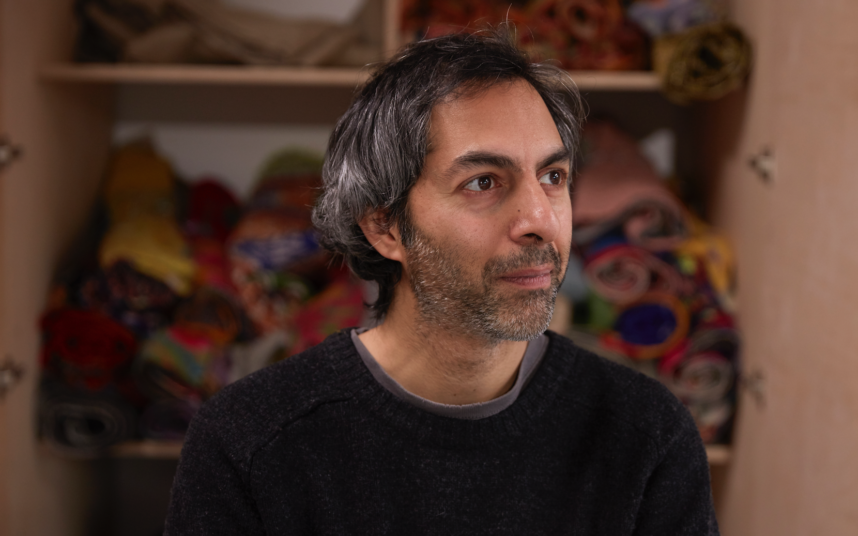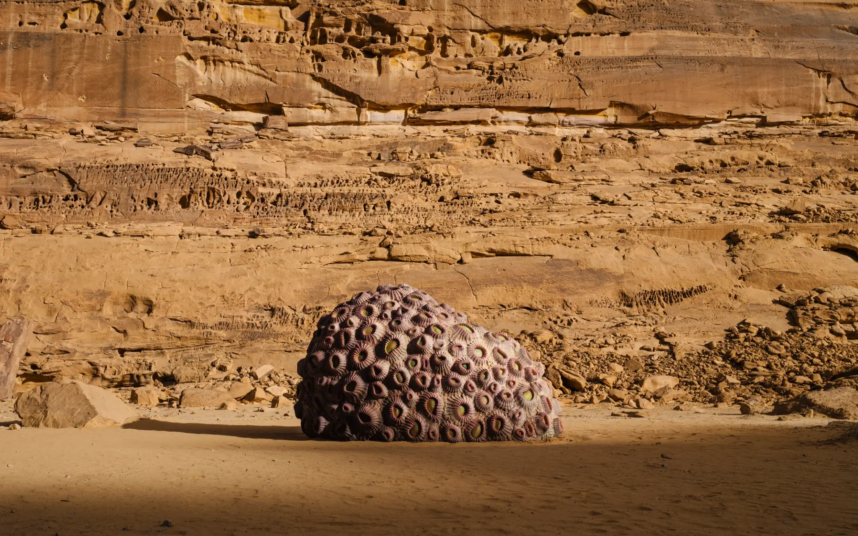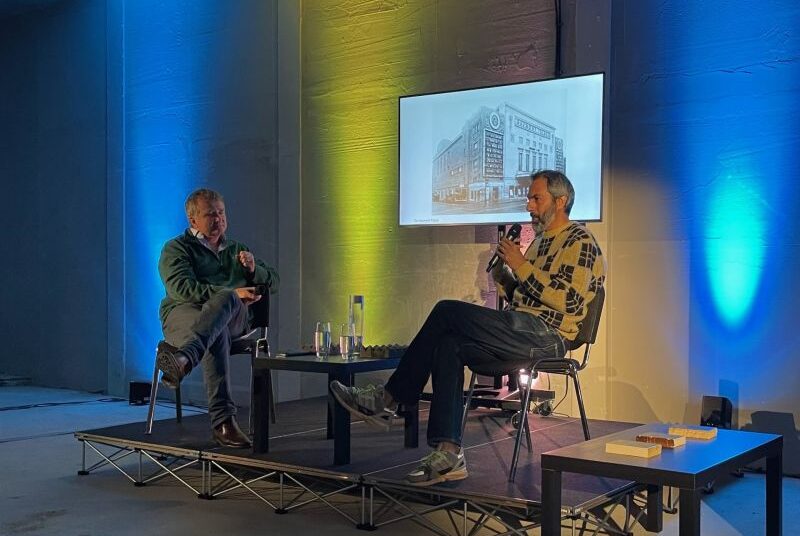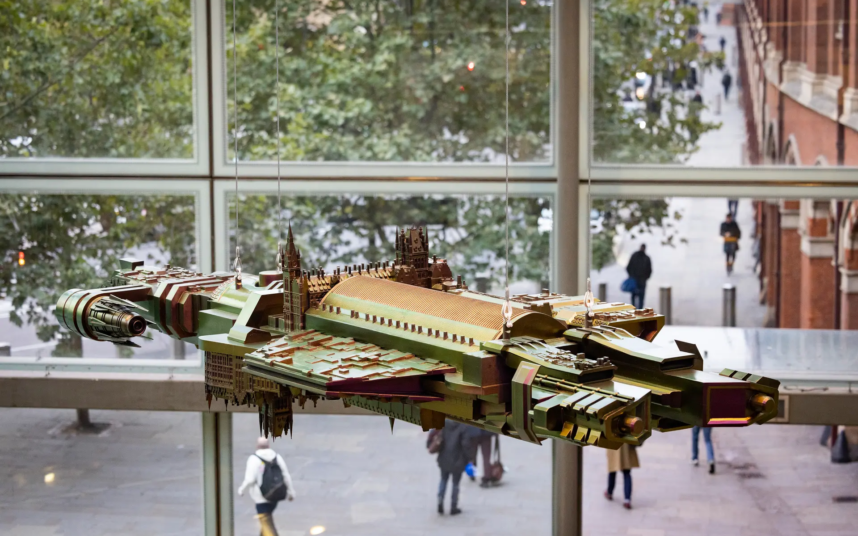Futurecity are proud to announce the second of two new public art commissions for artist Shezad Dawood, the London based multidisciplinary artist. Futurecity Senior Curator Sinéad McCarthy recently met Shezad Dawood to discuss his practice, the commissions, working with Futurecity and his interest in the intersection between architecture, history and ecology.
Shezad has been selected for a new Cambridge Biomedical Campus (CBC) public art commission. This is one of a series of permanent and temporary artworks produced and curated by Futurecity for client Prologis. CBC is a vibrant, international healthcare community and a global leader in medical science, research, education and patient care.
In 2021, Shezad Dawood was commissioned by Cadogan to deliver a new commission for ‘The Gaumont’ a mixed-use development, which includes a cinema, ‘creative cluster’, and a meticulously restored heritage façade on London’s King Road. Dawood’s design for two large panels (on the façade of the original 1930’s Gaumont Palace Theatre) honours its cinematic and theatrical past, playing with the subject of time, the cycles of night and day, cinematic references and the location in the iconic Kings Road.
Shezad Dawood is a multidisciplinary artist who interweaves stories, realities and symbolism to create richly layered artworks, spanning painting, textiles, sculpture, film and digital media. Fascinated by ecologies and architecture, his work takes a philosophical approach, asking questions and exploring alternative futures through what Dawood describes as ‘world-building’ and ‘imagineering’. His practice is animated by research, working with multiple audiences and communities to delve into narrative, history and embodiment.
—

Image: Shezad Dawood in the studio, photo by Sue Parkhill. Courtesy of the artist.
Sinéad McCarthy (SM): To start with, can you explain your particular areas of interest and exploration within your artistic practice?
Shezad Dawood (SD): My interest is so broad. I guess there are two main strands to the work – one is around ecology and the other one is around architecture. So, interestingly, the natural environment and the built environment; but I don’t actually see them as opposed. I think they have a nice relationship to each other in that we’re never outside of nature. I don’t believe in that sort of false or forced separation.
SM: And in terms of the ecology is it the relationship between ourselves, the artwork and with our lived environments?
SD: With ecology, it’s really come out of an interest that comes through research. I guess I’m always looking for something that reveals a truth that’s always been there or a new way of looking at something. So, for example, with my large outdoor coral works, there’s always this desire to make the invisible visible.
I’m particularly passionate about coral reef systems, amongst other biomes, but I just feel like coral reef ecosystems are beautiful, they’re wonderful, they host biodiversity, but they also act as a barrier in terms of tidal waves, tsunamis. So they are much more of a fault line for human coastal civilisation. I don’t think we fully appreciate their structural importance in terms of safeguarding everything. From fisheries to coastal erosion, et cetera.
You know I’m also interested in deep time cycles. I’ve placed corals into desert environments; I’m interested in how deserts were once oceans and might well be so again.
I guess I’m always looking for something that reveals a truth that’s always been there or a new way of looking at something.

Image: Coral Alchemy I (Dipsastraea Speciosa), 2022. With thanks to Adam Lowe and Factum Arte, Madrid. Photography Lance Gerber. Courtesy of the artist.
SM: I guess what you’re exploring is the kind of cyclical nature of time and of evolution within different systems, how has your interest in the past and future of ecosystems evolved?
SD: I think it’s collapsing those things. I think we’ve learnt to live in the midst of a number of opposing categories like past, present, future, but of course they all inform each other. And I think it’s really important to start to think more organically about how different times, different structures in nature, including us, connect through mutual need.
Often I think as an artist, your role is to tease something out that maybe language hasn’t been able to articulate so far.
There’s something about that visual and visceral impact. And talking about cycles, I was interested in this sort of deep time cycle, condensing it into a 24-hour cycle. For example, with the coral alchemy projects I’ve done, they’re treated with a thermochromic paint, so they change colour according to the ambient heat and light throughout the day.
Often I think as an artist, your role is to tease something out that maybe language hasn’t been able to articulate so far.
SM: It is amazing that through your artworks, you actually make people aware of the human impact on coral reefs, an accelerated timeline playing out as they’re standing in front of them and watching them change.
It would be nice to hear about what draws you to a commissioning opportunity; what is the main attractor, or what would pique your interest?
SD: I think it generally has to kind of connect thematically, both through environmental awareness as well as having a social impact where you’re actually able to interface with a community or communities and think about how they inform the work and the work informs them or their community.
I think that the idea of reciprocity is really central. It’s a drum I’ve been banging for many, many years, to where it became a demand. I was often almost forcing it on commissioners – asking why it doesn’t have any relation to the community. I’m interested in who are the stewards, owners, participants, activators who have the work, and what is the point?
And then connecting to the environment in so many ways, not just ecology as a subject matter, but also to architecture and to the built environment. It’s all about layers of environment and how we participate, respond, act as stewards for our environment. It’s got to have that kind of ethos, or an opportunity to connect to it.

Image: Coral Alchemy (Acropora Grove), 2023. Manar Abu Dhabi, Abu Dhabi 2023. Courtesy of the artist and DCT Abu Dhabi. Photography © Lance Gerber.
SM: Part of your process has to do with collaboration with designers, architects and also non-traditional stakeholders like researchers, scientists and others. But when working on a commission there’s also conversations with clients, curators, advisory groups and other people who bring expertise and perspectives from non-arts backgrounds. Can you talk a little bit about the process for those conversations and collaborations and the value in them?
SD: I think because with a lot of the research within my practice, I’m often talking to non-arts people: scientists, climatologists, marine biologists, plant communication specialists. It’s quite a privilege to be able to do that. I don’t think I’m ever looking to come up with an idea in isolation anyway. So for me, I quite enjoy working with clients, advisory boards, commissioners, because you’re asking ‘would you think of this’ and negotiating it together.
Often as part of a commission, based on where it is, you are asking ‘what makes an interesting commission’? Often if there is someone related to the site, or that location, whether it’s a research institution or a particular person in the field that is usually how I go about finding that hook.
And I like to challenge the client by asking ‘Have you thought of this?’. I think that’s where we’ve been very privileged to be very successful and work with some really fantastic clients and commissioners, too, because we do push the envelope, and we really try and go above and beyond and deliver something that’s unique for each project.
SM: Reflecting on your career, how do you think your practice has changed over the years? There are lots of different strands to what you produce in terms of artworks. How would you describe how it has evolved?
SD: I think it’s over a slow burn of a long career. I think it’s always expanding and evolving in that way where the work just gets better. And as a result, a lot of the projects are starting to get more ambitious, more risk taking. And therefore each project is an excitement in itself.
So in that way, each client, each commission, is like a new journey. And similarly, with each body of new work in the studio, as we’re developing something perhaps in partnership with one or two museums or institutions, that’s a journey as well. And I think it’s being able to go on a journey together with other people that explores new uncharted territory.
I think that’s probably the most important and the most exciting thing in life now is to be trying out new things and new ideas and collaboratively seeing if you can demonstrate to people and audiences new ways of seeing the world and interacting with it, giving people that spark.
So in that way, each client, each commission, is like a new journey. And similarly, with each body of new work in the studio, as we’re developing something perhaps in partnership with one or two museums or institutions, that’s a journey as well. And I think it’s being able to go on a journey together with other people that explores new uncharted territory.

Image: Private launch of Shezad Dawood’s façade installation for ‘The Gaumont’ by Cadogan, which celebrates the site’s cinematic heritage.
SM: I think that demonstrates what the joy of art is and particularly how that applies to public art. It’s about bringing people on that journey, maybe people who don’t think they have an interest in art, realising there are different hooks for them. It is the potential of people encountering a space or looking at something slightly differently but just as they are on their journey through the world.
To conclude, could you also talk a little bit about your current or new directions that your work has been taking recently?
SD: Yes, having worked with marine ecology for so long, I have been doing a lot of research in the background about gardens and plants and communication between plants. I did a solo show at WIELS in Brussels last year called Night in the Garden of Love, which was exploring the mystical idea of the garden and the potentialities of it, inspired by the African American musician Yusef Lateef, whose estate I’ve been working with for many years. I think that direction looks set to continue through various commissions and projects that I’m developing at the moment.
I am very much looking at moving from sea onto land; and what are some other possibilities there to rethink our relationship to the nonhuman and other species.

Image: HMS Alice Liddell, 2022. St. Pancras Wires commission. Courtesy of the artist.
To find out more about Shezad Dawood’s practice, visit the website.
To sign up for the latest Futurecity News updates, including commission launches, sign up for our mailer.
